Sanjiang Chengyang Wind And Rain Bridge: A Cultural Gem in China’s Countryside
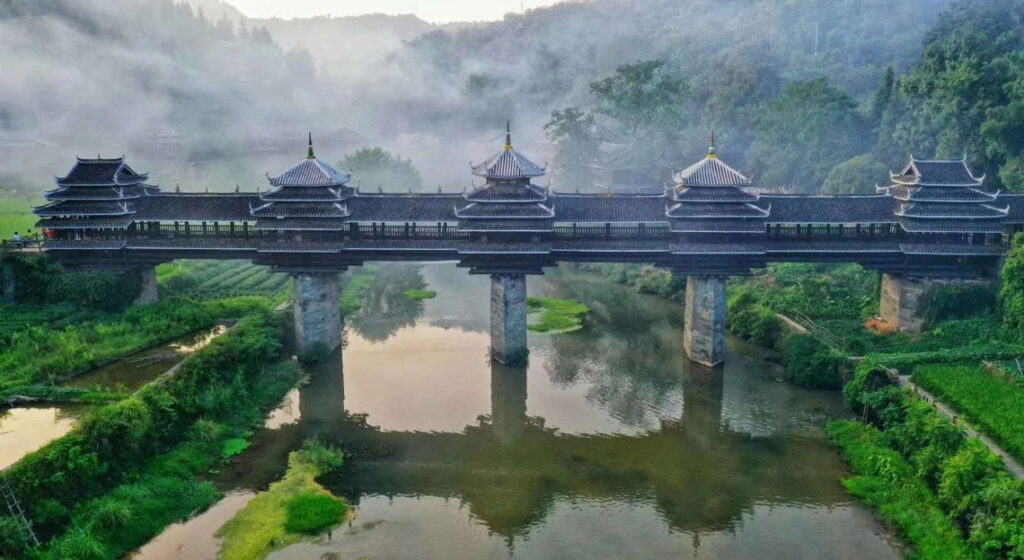
An Essential Guide to Visiting Sanjiang Chengyang Wind And Rain Bridge
Nestled in the picturesque hills of Guangxi Province, the Sanjiang Chengyang Wind and Rain Bridge stands as a testament to the rich cultural heritage and architectural ingenuity of the Dong people. Spanning the serene Linxi River, this magnificent structure is not just a bridge; it’s a vibrant gathering place that encapsulates the spirit of community and tradition. With its five sturdy stone pillars supporting intricately designed wooden pavilions, the bridge showcases the unique craftsmanship that has been passed down through generations.
As you approach the bridge, you’ll be greeted by the breathtaking scenery of lush tea plantations and charming wooden houses that seem to emerge organically from the landscape. This area, comprised of eight picturesque villages, offers a glimpse into the daily lives of the Dong community, where age-old customs thrive amidst the beauty of nature. Whether you’re looking to immerse yourself in local culture, embark on scenic hikes, or simply revel in stunning vistas, the Chengyang Wind and Rain Bridge serves as the perfect starting point for your adventure. Here, the gentle hum of the river and the warm smiles of the villagers invite you to slow down, explore, and experience the heart of rural China like never before.
In This Guide
- An Essential Guide to Visiting Sanjiang Chengyang Wind And Rain Bridge
- The Rich History and Legends of Sanjiang Chengyang Wind And Rain Bridge
- Main Highlights: What You Absolutely Can’t Miss
- Planning Your Visit: A Practical Guide
- Tickets: Prices, Booking, and Tips
- How to Get There: A Complete Transportation Guide
- Local Cuisine and Accommodation Nearby
- Frequently Asked Questions
- Final Thoughts on Your Trip
The Rich History and Legends of Sanjiang Chengyang Wind And Rain Bridge
Nestled in the picturesque countryside of southern China, the Sanjiang Chengyang Wind and Rain Bridge embodies a rich tapestry of cultural heritage and architectural ingenuity. Built in the late 20th century, this remarkable structure stands as a testament to the traditions of the Dong people, an ethnic minority renowned for their craftsmanship and communal spirit.
The bridge, known as Fengyu Qiao in Mandarin, stretches approximately 64 meters in length and is elegantly supported by five solid stone pillars, each crowned with a multi-story wooden pavilion. Its construction is particularly noteworthy; it is said to have been built entirely without nails, relying solely on traditional wooden joints to hold the beams and planks together. This method not only showcases the mastery of ancient building techniques but also reflects the profound connection the Dong people have with nature and their surroundings.
The purpose of the Wind and Rain Bridge extends beyond mere functionality. It serves as a gathering place for the villagers, providing shelter from the elements while also fostering social interaction. The bridge is strategically located over the Linxi River, allowing locals and visitors alike to enjoy the breathtaking views of the surrounding landscape, dotted with lush tea plantations and traditional wooden houses.
Historically, this area has been a hub of activity and commerce for centuries, with the bridge playing a vital role in facilitating trade and communication among the eight villages of Chengyang. The structure has witnessed countless stories unfold—families crossing the river to visit friends, traders transporting goods, and generations of Dong people celebrating festivals and traditions while sheltered beneath its ornate roofs.
Legends surrounding the bridge often highlight its significance as a symbol of unity and resilience. It is said that the bridge has the power to bring good fortune to those who cross it, blessing them with safe travels and a prosperous life. As such, it has become a focal point for various cultural events, including traditional dance performances and local markets where artisans sell handmade crafts, further weaving the bridge into the fabric of daily life in Chengyang.
Today, the Sanjiang Chengyang Wind and Rain Bridge remains one of the largest and most beautiful of its kind, among approximately 100 similar structures in the region. It stands not only as an architectural marvel but also as a living monument to the enduring spirit of the Dong people, inviting travelers from around the globe to experience its beauty and the rich history that surrounds it. Whether you’re strolling across its wooden planks or admiring it from a nearby vantage point, the bridge offers a glimpse into a unique cultural legacy that continues to thrive in this idyllic corner of China.
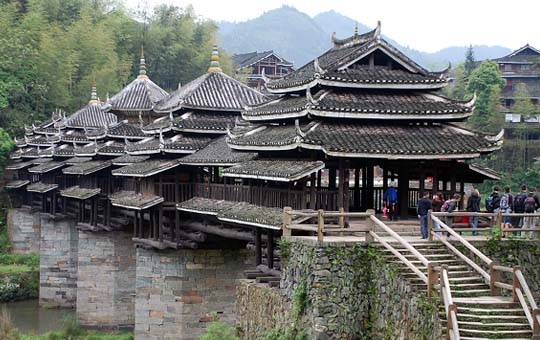
Sanjiang Chengyang Wind And Rain Bridge.
Main Highlights: What You Absolutely Can’t Miss
When exploring the enchanting region of Chengyang in Sanjiang, the Wind and Rain Bridge stands out as a must-see attraction that encapsulates the unique culture and stunning natural beauty of the area. Here’s what you absolutely cannot miss during your visit:
The Architectural Marvel of the Chengyang Bridge
The Chengyang Wind and Rain Bridge, known in Mandarin as Fengyu Qiao, is a breathtaking example of traditional Dong architecture. Spanning approximately 64 meters (210 feet) long and standing 10 meters (33 feet) high, this covered bridge is supported by five sturdy stone pillars, each crowned with a charming wooden pavilion. What makes this bridge particularly fascinating is that it was constructed without a single nail, using intricate wooden joints to hold the structure together.
Tip: Take a moment to admire the unique layered roofs and intricate wooden carvings, which not only serve an aesthetic purpose but also protect villagers from the elements.
Scenic Views Over the Linxi River
From the bridge, visitors are treated to stunning views of the meandering Linxi River and the picturesque Dong villages nestled in the lush greenery. The vibrant rice fields, tea plantations, and traditional wooden houses create a breathtaking panorama that is perfect for photography enthusiasts.
Don’t Miss: Walk along the bridge and find a spot to sit and watch the daily activities of the villagers as they go about their routines.
Cultural Experiences and Local Handicrafts
The area surrounding the Wind and Rain Bridge is rich in Dong culture. Local women often sell beautiful handmade embroidery and traditional cotton blankets on the bridge. Look out for the striking blue-black Dong jackets, crafted from indigo-dyed fabric, which make for perfect souvenirs.
Cultural Insight: Engage with the local artisans, who are often happy to share the stories behind their crafts, enhancing your understanding of this vibrant culture.
Hiking Trails and Natural Wonders
Chengyang is surrounded by breathtaking hiking trails that offer a deeper immersion into the region’s natural beauty. Popular routes include a scenic hike from Chengyang to Mapang, passing through charming villages and offering views of rolling hills and terraced fields.
Hiking Recommendation: The trail from Chengyang to Mapang takes about six hours and showcases various aspects of Dong architecture, including the Mapang Drum Tower. Be sure to wear comfortable walking shoes and carry water!
Drum Tower and Surrounding Villages
Just a short distance from the bridge, you’ll find the iconic Mapang Drum Tower, an important cultural symbol for the Dong people. This square tower often serves as a gathering place for local festivities and is a fantastic spot for cultural immersion.
Explore Further: Venture into the nearby villages to experience traditional Dong music, dance performances, and possibly even partake in a local meal at a farmer’s house.
Viewpoints for the Perfect Picture
For those seeking breathtaking views, hike up the trail to the two pavilions overlooking Chengyang. These viewpoints offer a stunning vantage point to capture the idyllic scenery of the villages surrounded by lush fields.
Photo Tip: Visit during golden hour for the best light to capture the enchanting beauty of the valley and its traditional architecture.
Conclusion
The Chengyang Wind and Rain Bridge is not just a bridge; it’s a gateway to the rich cultural tapestry and stunning landscapes of the Dong people. Whether you’re marveling at its unique architecture, enjoying the natural beauty, or engaging with local traditions, this destination promises a memorable experience that captures the essence of rural China. Don’t miss this gem on your journey through the captivating landscapes of Sanjiang!
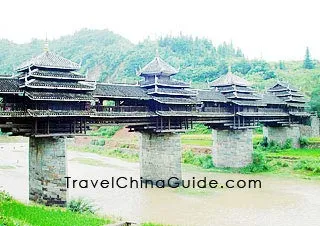
Sanjiang Chengyang Wind And Rain Bridge.
Planning Your Visit: A Practical Guide
Planning Your Visit: A Practical Guide
Visiting the Sanjiang Chengyang Wind and Rain Bridge is an enchanting experience that immerses you in the rich traditions and stunning landscapes of China’s Dong ethnic culture. Whether you’re a history enthusiast, a nature lover, or simply looking for an off-the-beaten-path destination, this guide will help you navigate your trip seamlessly.
Getting There
The Chengyang Wind and Rain Bridge is located approximately 18 kilometers north of Sanjiang County, nestled in the picturesque Linxi River valley. The area is about a five-hour drive northwest of the more famous tourist hubs of Guilin and Yangshuo.
- By Bus: Public buses run regularly from Sanjiang to Chengyang. This is a budget-friendly option, costing around 10-20 RMB (approximately $1-$3) and takes about 30 minutes.
- By Private Transfer: For a more comfortable journey, consider hiring a private car or taxi. Rates can vary, so it’s advisable to negotiate in advance.
Best Time to Visit
The ideal time to visit Chengyang is during spring (March to May) and autumn (September to November). During these months, the weather is mild, and you can enjoy the lush green landscapes and blooming tea plantations. Summers can be hot and humid, while winters may see cooler temperatures and occasional rain.
Entrance Fees and Opening Hours
Visiting the Chengyang Wind and Rain Bridge requires a small entrance fee of approximately 30 RMB (around $5). The bridge is open year-round, but the best time to appreciate its beauty is during daylight hours when the sun illuminates its intricate wooden structure.
What to Expect
As you approach the bridge, you’ll be captivated by its unique architecture featuring five solid stone pillars, each topped with a wooden pavilion adorned with multiple layered roofs—an aesthetic that beautifully blends form and function. The bridge spans about 64 meters (210 feet) and stands 10 meters (33 feet) high, providing stunning views of the Linxi River and the surrounding countryside.
- Shopping: Local women often sell traditional Dong handicrafts, such as beautifully embroidered textiles and distinctive blue-black jackets. Purchasing these items supports the local community and provides you with a memorable souvenir.
- Cultural Performances: Depending on the season, you might be able to catch traditional dance performances that showcase the vibrant culture of the Dong people, often for an additional fee.
Exploring the Surroundings
The Chengyang area is a hiker’s paradise, with numerous trails that weave through the scenic countryside. Popular routes include:
- Chengyang to Mapang: A six-hour hike that takes you through lush fields and charming villages, culminating at the iconic Mapang Drum Tower.
- Chengyang Loop: A full-day hike connecting the villages of Pingtan, Gaoma, and Jichang, offering breathtaking views and opportunities to experience local life.
Guesthouses and local accommodations are available in both Chengyang and Sanjiang, often starting at around 15 RMB (approximately $2) for dormitory-style lodging. The Chengyang National Hostel and the Dong Village Hotel are popular choices among backpackers.
Practical Tips
- Language: While Mandarin is the official language, English may not be widely spoken in rural areas. Download translation apps or carry a phrasebook to help communicate.
- Cash is King: While larger towns may have ATMs, many transactions in Chengyang are cash-based. Ensure you have enough cash on hand for your purchases.
- Respect Local Customs: The Dong people are known for their hospitality. Always ask for permission before taking photographs of individuals, especially in traditional attire.
Conclusion
Visiting the Sanjiang Chengyang Wind and Rain Bridge is not just about seeing a unique architectural marvel; it’s about experiencing the vibrant culture and natural beauty of the Dong people. With this practical guide in hand, you’re well-equipped to plan an unforgettable visit to this hidden gem in China. Enjoy your adventure!
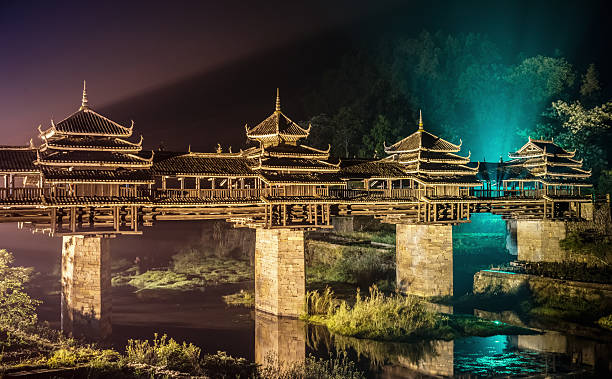
Sanjiang Chengyang Wind And Rain Bridge.
Tickets: Prices, Booking, and Tips
When planning your visit to the enchanting Sanjiang Chengyang Wind and Rain Bridge, there are a few key details to keep in mind regarding ticket prices, booking options, and tips to enhance your experience.
Ticket Prices
Access to the Chengyang Wind and Rain Bridge is quite affordable, with an entrance fee of approximately 30 RMB (around $4.50 USD). This nominal cost allows you to explore the bridge and its surrounding scenic views, making it accessible for travelers on a budget.
Booking Options
While you can purchase tickets directly at the entrance of the bridge, it’s advisable to check if any guided tours include the bridge visit. Many local travel agencies offer day tours from nearby cities like Guilin or Yangshuo that encompass the bridge along with other attractions in the area. These tours often provide insights into the local Dong culture and the stunning architecture of the bridge, enhancing your overall experience.
Tips for Your Visit
-
Timing: The bridge is particularly picturesque at dawn and dusk, when the natural lighting casts a beautiful glow over the architecture and the Linxi River. Aim to arrive early in the morning or late in the afternoon for stunning photographs.
-
Cultural Experience: Keep an eye out for local vendors selling traditional Dong embroidery and other handmade crafts on the bridge. Purchasing these items not only supports the local economy but also gives you a unique souvenir from your trip.
-
Exploration: Take time to wander the trails around Chengyang. The area features picturesque hiking routes that lead you through tea plantations and offer views of the surrounding villages. Consider packing a lunch to enjoy a local meal in one of the welcoming farmer’s houses.
-
Local Accommodations: If you want to extend your visit, there are several guesthouses and hostels in Chengyang and nearby Sanjiang. Prices can be as low as 15 RMB (around $2 USD) for dormitory-style accommodations, making it a great option for backpackers.
In summary, visiting the Sanjiang Chengyang Wind and Rain Bridge offers both an affordable entry point into stunning cultural architecture and a gateway to the surrounding natural beauty. By planning ahead and considering these tips, you’ll make the most of your experience in this picturesque part of China.
How to Get There: A Complete Transportation Guide
To embark on your journey to the enchanting Sanjiang Chengyang Wind and Rain Bridge, you’ll find that reaching this picturesque destination involves a few straightforward steps. Nestled in the heart of the Dong people’s culture, the bridge is located in Chengyang, a charming area about 18 kilometers north of Sanjiang and approximately five hours northwest of the bustling tourist hub of Guilin. Here’s your complete transportation guide to get there smoothly.
Getting to Sanjiang
-
By Air:
The nearest major airport is Guilin Liangjiang International Airport (KWL), which offers both domestic and international flights. From the airport, you can catch a taxi or a shuttle bus to Guilin city center. -
By Train:
Guilin has a well-connected railway system. You can take a train from major cities like Beijing, Shanghai, or Guangzhou to Guilin Railway Station. From there, you can continue your journey to Sanjiang. -
By Bus:
If you’re traveling from Guilin, taking a long-distance bus is an efficient option. Buses frequently depart from Guilin Qintan Bus Station to Sanjiang, with a journey time of around 4-5 hours. Buses are generally comfortable and provide a scenic route through the countryside.
From Sanjiang to Chengyang Wind and Rain Bridge
Once you arrive in Sanjiang, your adventure to the Chengyang Wind and Rain Bridge is just beginning:
-
Local Bus:
From the Sanjiang Bus Station, look for local buses heading to Chengyang. The buses are inexpensive and operate regularly, making it easy to reach your destination in approximately 30-40 minutes. -
Taxi or Rideshare:
For a more direct route, you can opt for a taxi or rideshare service from Sanjiang to Chengyang. This will give you the flexibility to travel at your own pace and enjoy the scenic views along the way. -
Bicycle Rentals:
If you’re feeling adventurous, consider renting a bicycle in Sanjiang. The ride to Chengyang will allow you to immerse yourself in the stunning landscapes, tea plantations, and rural life of the Dong people. The distance is manageable for most cyclists.
Navigating Chengyang
Upon arrival in Chengyang, the Wind and Rain Bridge is easily accessible:
-
Walking: The bridge is located in the heart of Chengyang and can be reached on foot from the bus station or taxi drop-off point. Enjoy the charming wooden houses and vibrant fields as you stroll through the village.
-
Guided Tours: Many local tour operators offer guided experiences that include transportation from Sanjiang to Chengyang. This option can enhance your visit, providing insights into the local culture and history.
Final Tips
- Language: It’s helpful to have basic Mandarin phrases ready or a translation app, as English may not be widely spoken in rural areas.
- Cash: While some places may accept mobile payments, it’s advisable to carry cash (RMB) for small purchases and transportation.
- Timing: Plan your visit during daylight hours to fully appreciate the scenic beauty and avoid navigating unfamiliar routes in the dark.
By following this transportation guide, you’ll be well-equipped to explore the stunning Chengyang Wind and Rain Bridge and the surrounding Dong culture with ease. Safe travels!

Sanjiang Chengyang Wind And Rain Bridge.
Local Cuisine and Accommodation Nearby
Nestled in the picturesque valley of Chengyang, near the stunning Wind and Rain Bridge, you’ll find a delightful array of local cuisine and cozy accommodations that offer a taste of the region’s rich culture and hospitality.
Local Cuisine
The culinary offerings around the Chengyang area reflect the traditional flavors of the Dong people, characterized by fresh, locally-sourced ingredients. Here are some must-try dishes:
-
Dong Style Rice: Known for its unique preparation, this rice dish is often steamed or served with various toppings. Look for local eateries where you can enjoy it with pickled vegetables or spicy sauces.
-
Grilled Fish: Fresh from the Linxi River, grilled fish is a popular dish here. Many local restaurants offer this delicacy, often marinated with local herbs and spices, making it a flavorful treat.
-
Sticky Rice: A staple in Dong cuisine, sticky rice is often served in bamboo tubes, imparting a distinct flavor. Pair it with sweet or savory fillings for an authentic experience.
-
Dong Noodles: These hand-pulled noodles are a must-try. Served in a hearty broth with seasonal vegetables and meats, they are perfect after a day of hiking.
-
Local Snacks: Don’t miss the chance to sample local snacks like rice cakes and fried pastries from street vendors, which are perfect for on-the-go munching.
For an even more immersive experience, consider dining in a local farmer’s home. Many families offer home-cooked meals, providing a unique insight into the Dong culture and culinary traditions.
Accommodation Options
After a day of exploring the stunning landscapes and unique architecture, retreat to one of the nearby accommodations that cater to both comfort and affordability:
-
Chengyang National Hostel: A great budget option, this hostel offers dormitory-style accommodations starting around 15 RMB (approximately $2 USD). It’s an excellent choice for backpackers and provides helpful information about local trails and attractions.
-
Dong Village Hotel: Also offering dorm beds for around 15 RMB, this hotel is known for its friendly atmosphere and clean facilities. It’s conveniently located for easy access to the Wind and Rain Bridge and local hiking trails.
-
Local Guesthouses: Various guesthouses in the villages provide a more intimate experience, often featuring traditional wooden architecture. Many guesthouses offer meals prepared with fresh local ingredients, giving you a taste of authentic Dong hospitality.
-
Sanjiang Hotels: For those seeking a bit more comfort, hotels in the nearby town of Sanjiang offer a range of accommodations from mid-range to upscale, making them ideal for a restful night after your adventures.
Final Thoughts
Whether you’re enjoying a delicious bowl of Dong noodles or resting in a cozy guesthouse surrounded by the serene beauty of Chengyang, the local cuisine and accommodations near the Wind and Rain Bridge promise to enhance your travel experience in this charming corner of China. Embrace the culture, savor the flavors, and create lasting memories in this picturesque destination.
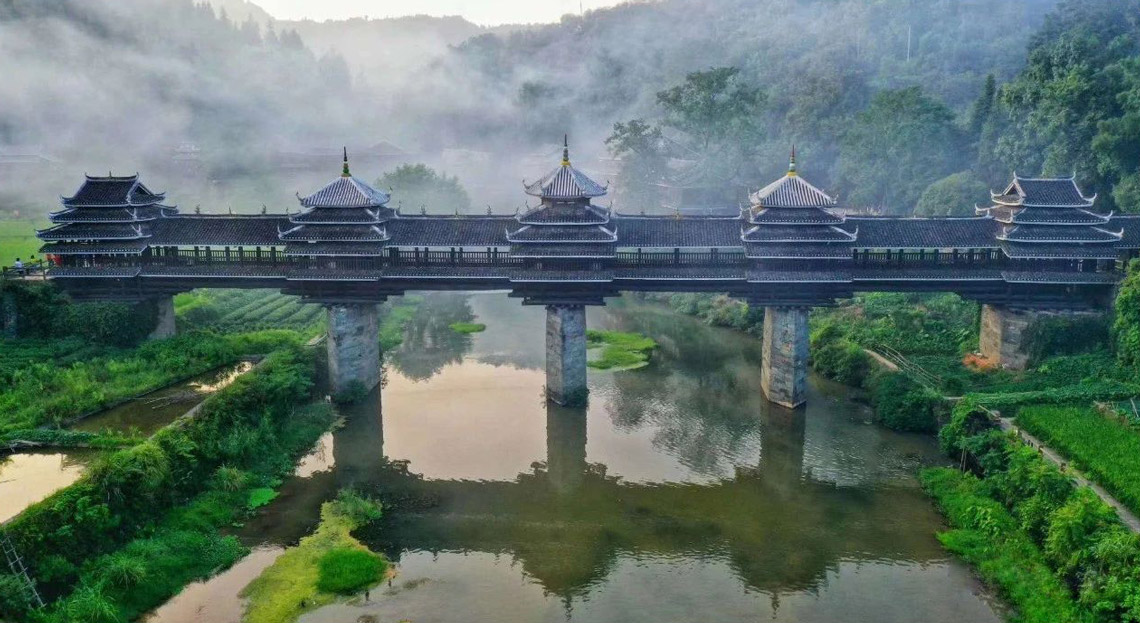
Sanjiang Chengyang Wind And Rain Bridge.
Frequently Asked Questions
-
What is the best time to visit the Chengyang Wind and Rain Bridge?
The ideal time to visit Chengyang is during the spring (April to June) and autumn (September to November) months when the weather is mild and the scenery is particularly stunning. Summers can be humid, while winters might bring cooler temperatures. -
How do I get to Chengyang from Guilin?
Chengyang is approximately a five-hour drive northwest of Guilin. You can take a bus from Guilin to Sanjiang and then transfer to a local bus or taxi to reach Chengyang. Alternatively, consider hiring a private car for a more comfortable journey. -
Is there an entrance fee to visit the Chengyang Wind and Rain Bridge?
Yes, there is a nominal entrance fee of about 30 RMB (approximately $5) to access the bridge. This fee helps maintain the structure and surrounding area. -
Are there any accommodations near the Chengyang Wind and Rain Bridge?
Yes, there are several guesthouses and hotels in the Chengyang area that cater to travelers. Options like the Chengyang National Hostel offer budget dormitory beds for about 15 RMB ($2), making it an affordable choice for backpackers. -
What activities can I do around the Chengyang Wind and Rain Bridge?
Besides admiring the bridge’s unique architecture, you can enjoy scenic hikes in the surrounding countryside, visit traditional Dong villages, explore tea plantations, and even participate in local cultural performances if available. -
Can I buy local handicrafts at the bridge?
Absolutely! Local vendors often sell beautiful embroidered items, cotton blankets, and traditional Dong jackets near the bridge. These make for unique souvenirs and support the local community. -
Are there guided tours available for the Chengyang area?
Yes, there are various guided tours that include visits to the Chengyang Wind and Rain Bridge along with other nearby attractions. These tours can provide insights into the local culture and history, making your visit even more enriching. -
Is hiking around Chengyang suitable for beginners?
Yes, many hiking trails around Chengyang are accessible to beginners. The terrain varies, and there are several routes that take you through picturesque landscapes, rice fields, and villages, allowing you to enjoy the natural beauty at your own pace.
Final Thoughts on Your Trip
As you wrap up your journey to the enchanting Sanjiang Chengyang Wind and Rain Bridge, take a moment to reflect on the rich tapestry of experiences that have unfolded before you. This remarkable structure, with its intricate architecture and historical significance, serves as a gateway not just to the picturesque landscapes of the Dong villages, but also to the vibrant culture and traditions of the local people.
Wandering through the charming clusters of wooden houses, hiking along the rolling hills, and gazing at the meandering Linxi River, you have immersed yourself in the serene beauty of this farming community. The warm smiles of local farmers and the vibrant crafts they offer add a personal touch to your adventure, allowing you to connect with the essence of the Dong culture.
Whether you marveled at the bridge’s unique design or savored a meal in a local home, each moment spent here has left an indelible mark on your travel story. As you prepare to leave this hidden gem behind, carry with you the tranquility of the countryside, the artistry of the embroidery, and the harmonious spirit of the Dong people. Sanjiang Chengyang is not merely a destination; it is a memory that will inspire you long after you’ve returned home. Embrace the journey ahead, knowing you have glimpsed a world where tradition and nature intertwine beautifully.